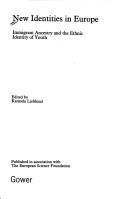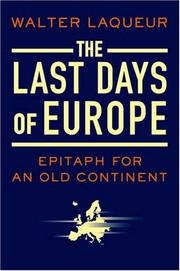| Listing 1 - 10 of 50 | << page >> |
Sort by
|

ISBN: 0566057417 9780566057410 Year: 1989 Publisher: Aldershot, Hants, England: Gower,
Abstract | Keywords | Export | Availability | Bookmark
 Loading...
Loading...Choose an application
- Reference Manager
- EndNote
- RefWorks (Direct export to RefWorks)
Immigrants --- Ethnicity --- Youth --- Psychology --- Europe --- Europe - Foreign population. --- Ethnicity - Europe. --- Immigrants - Europe - Psychology. --- Youth - Europe - Psychology. --- Immigrants - Europe --- Ethnicity - Europe --- Immigrants - Europe - Psychology --- Youth - Europe - Psychology
Book
ISBN: 1782204725 9781782204725 Year: 2017 Publisher: London: Karnac,
Abstract | Keywords | Export | Availability | Bookmark
 Loading...
Loading...Choose an application
- Reference Manager
- EndNote
- RefWorks (Direct export to RefWorks)
There are political, economic, legal, medical, cultural and religious aspects of the present refugee crisis in Europe. Difficulties in border crossings, settlement programs, life-saving issues and security measures present themselves immediately. The refugee crisis also needs to be examined from a psychological view point. Changes in the 21st Century are occurring at an unprecedented pace and scale. Globalization, incredible advances in communication technology, fast travel, recourse limitations, terrorist activities and now the refugee crisis in Europe make psychoanalytic investigation of the Other a major necessity. In part I, case examples illustrate the impact of traumatic experiences, age-factors, large-group identity issues, and trans-generational transmissions. The meanings of the newcomers' utilization of linking objects and linking phenomena are explored. Part II focuses on the host countries. A detailed description of the evolution of prejudice, especially collective prejudice, against the Other is provided. Also, the psychology of borders is presented. The importance of psychoanalysts' experiences in examining societal and political matters and their search for ways to communicate their findings to other mental health workers, educators, professionals dealing with refugee crises, and the public in general, are addressed throughout the book
Immigrants --- Refugees --- Psychology. --- Psychology --- Immigrants - Europe - Psychology --- Refugees - Europe - Psychology
Book
ISBN: 2867389739 9782867389733 Year: 1993 Publisher: Paris: Syros,
Abstract | Keywords | Export | Availability | Bookmark
 Loading...
Loading...Choose an application
- Reference Manager
- EndNote
- RefWorks (Direct export to RefWorks)
Refugees --- Réfugiés --- Immigrants --- Réfugié --- --Europe --- --Pictorial works --- Europe --- Emigration and immigration --- Government policy --- Réfugiés --- Immigrants - Europe - Pictorial works --- Immigrants - Europe --- Europe - Emigration and immigration - Government policy
Book
ISBN: 3799574581 9783799574587 Year: 2006 Volume: 62 Publisher: Ostfildern : Thorbecke,
Abstract | Keywords | Export | Availability | Bookmark
 Loading...
Loading...Choose an application
- Reference Manager
- EndNote
- RefWorks (Direct export to RefWorks)
Immigrants --- History --- Immigrants - Europe - History - Congresses. --- Immigrés --- Europe --- Histoire --- Congrès --- Émigration et immigration

ISBN: 9780312368708 0312368704 Year: 2007 Publisher: New York: St. Martin's press,
Abstract | Keywords | Export | Availability | Bookmark
 Loading...
Loading...Choose an application
- Reference Manager
- EndNote
- RefWorks (Direct export to RefWorks)
"What happens when a falling birthrate collides with uncontrolled immigration? The Last Days of Europe explores how a massive influx from Asia, Africa, and the Middle East has Loaded Europe with a burgeoning population of immigrants, many of whom have no wish to be integrated into European societies, but make full use of the host nations' generous free social services."--BOOK JACKET
Immigrants --- Europe --- Social conditions --- Civilization --- Immigrants - Europe --- Europe - Social conditions - 21st century --- Europe - Civilization - 21st century
Book
ISBN: 9781409407492 9781409407508 1409407500 1409407497 1317072154 1282963317 9786612963315 9781315603391 9781317072140 9781317072157 9781138268289 1317072162 131560339X Year: 2011 Publisher: Farnham, Surrey, England Burlington, VT Ashgate
Abstract | Keywords | Export | Availability | Bookmark
 Loading...
Loading...Choose an application
- Reference Manager
- EndNote
- RefWorks (Direct export to RefWorks)
In the course of the last two decades, the number of arrests, imprisonment and detention of aliens and citizens of foreign origin has increased significantly in the West. This volume examines this growing trend towards racial criminalization and victimiza
Crime and race --- Racism --- Immigrants --- Race and crime --- Race-crime relationships --- Race --- Crime and race - Europe --- Racism - Europe --- Immigrants - Europe

ISBN: 2020314509 9782020314503 Year: 1997 Volume: 345 Publisher: Paris: Seuil,
Abstract | Keywords | Export | Availability | Bookmark
 Loading...
Loading...Choose an application
- Reference Manager
- EndNote
- RefWorks (Direct export to RefWorks)
Comparant, en historien et surtout en anthropologue, quatre sociétés "témoins", l'Amérique, l'Angleterrre, l'Allemagne et la France, l'auteur propose une nouvelle analyse de la question de l'immigration, dans le prolongement de ses travaux antérieurs sur les structures familiales.
Assimilation (Sociology) --- Immigrants --- Acculturation --- Segregation --- Social integration --- Intégration sociale --- Social conditions --- Conditions sociales --- Immigrants - Europe --- Immigrants - United States
Book
ISBN: 9781526464033 9781526464040 1526464047 1526464039 9781526492937 Year: 2020 Publisher: London: Sage,
Abstract | Keywords | Export | Availability | Bookmark
 Loading...
Loading...Choose an application
- Reference Manager
- EndNote
- RefWorks (Direct export to RefWorks)
The Making of Migration addresses the rapid phenomenon that has become one of the most contentious issues in contemporary life: how are migrants governed as individual subjects and as part of groups? What are the modes of control, identification and partitions that migrants are subjected to? Bringing together an ethnographically grounded analysis of migration, and a critical theoretical engagement with the security and humanitarian modes of governing migrants, the book pushes us to rethink notions that are central in current political theory such as "multiplicity" and subjectivity. This is an innovative and sophisticated study; deploying migration as an analytical angle for complicating and reconceptualising the emergence of collective subjects, mechanisms of individualisation, and political invisibility/visibility. A must-read for students of Migration Studies, Political Geography, Political Theory, International Relations, and Sociology.
Book
ISBN: 904852315X 9789089646484 9089646485 Year: 2014 Publisher: Amsterdam: Amsterdam university press,
Abstract | Keywords | Export | Availability | Bookmark
 Loading...
Loading...Choose an application
- Reference Manager
- EndNote
- RefWorks (Direct export to RefWorks)
The combination of increased migration, new technologies, and growing wealth have changed the face of Europe: today, one in ten Europeans was born outside the continent. The processes for incorporating these immigrants vary widely from city to city and nation to nation, and even from one institution within a city to another. This collection offers a comprehensive overview of the state of scholarship on all those approaches and their effectiveness, bringing current theory and practice together to analyze problems and debates in the field.
Immigrants --- Europe --- Emigration and immigration. --- Immigrants - Europe --- Europe - Emigration and immigration --- Immigrés --- Émigration et immigration. --- Assimilation. --- Europe. --- Integration. --- International migration. --- Multiculturalism. --- Émigration et immigration

ISBN: 1853597783 1853597791 1853597805 128082848X 9786610828487 9781853597800 9781853597794 9781853597787 6610828482 Year: 2004 Volume: 130 Publisher: Clevedon Multilingual Matters
Abstract | Keywords | Export | Availability | Bookmark
 Loading...
Loading...Choose an application
- Reference Manager
- EndNote
- RefWorks (Direct export to RefWorks)
This book focuses on the increase of urban multilingualism in Europe as a consequence of processes of migration and minorisation. It offers multidisciplinary, crossnational and crosslinguistic perspectives on immigrant minority languages at home and in school in six multicultural cities across Europe. In each of these cities, Germanic or Romance languages have a dominant status in public life. This Multilingual Cities Project is based on large-scale empirical findings and has been carried out under the auspices of the European Cultural Foundation, in Amsterdam. Part I offers multidisciplinary background information on phenomenological, demographic, language rights and educational aspects of the status of immigrant minority communities and their languages in a variety of international contexts. Part II offers methodological considerations on the Multilingual Cities Project. In addition, it presents both national and local perspectives on multilingualism in each of the six cities under consideration. Each chapter provides information on the distribution and vitality of immigrant minority languages spoken at home and on the status of these languages in primary and secondary schools. Part III offers crossnational and crosslinguistic perspectives on the twenty most prominent languages that emerge from the study. The focus is again on the two major private and public domains in which language transmission may or may not occur: the home and the school, respectively. The book offers a challenging outlook on the educational management of language diversity in the increasingly multicultural and multilingual context of European nation-states.
645 Sociolinguistiek --- #KVHA:Meertaligheid --- #KVHA:Communicatie --- Immigrants - Europe - Language. --- Immigrants --- Language and education --- Linguistic minorities --- Multilingualism --- Language. --- Sociolinguistics --- European Union --- Educational linguistics --- Education --- Language and languages --- Emigrants --- Foreign-born population --- Foreign population --- Foreigners --- Migrants --- Persons --- Aliens --- Language --- Multilingualism - Europe --- Linguistic minorities - Europe --- Immigrants - Europe - Language --- Language and education - Europe
| Listing 1 - 10 of 50 | << page >> |
Sort by
|

 Search
Search Feedback
Feedback About UniCat
About UniCat  Help
Help News
News